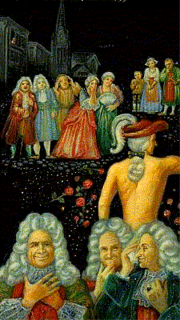
Carl Nielsen: Music Critic
Apart from having been a hilarious teenager (I've never seen a picture quite like this from the 1800s) and probably the most unduly neglected composer of the Twentieth Century, Carl Nielsen was also an insightful music critic. His little book of essays, Living Music, contains a wealth of sound advice and criticism for performers, composers, and musicologists alike.
One of the essays, entitled Mozart and Our Time, contains this brilliant quote:
“It is an offence against Mozart and against the young student of music, therefore, for a teacher to set his pupil to play Mozart’s sonatas and quartets as soon as he has acquired a modicum of technique. It is barbarous, in fact, and will only spoil the pupil’s desire to study Mozart subsequently. How can we expect young people to appreciate the exquisitely alternating moods of this music, or feel the beauty of an art which expresses itself with such restraint and in so strangely spiritual a manner! What youth wants, above all else, is something it can grasp, something it can lay hold on with both hands. But the content of Mozart’s music is the least tangible, and so it is better to let the young musician get his fingers into Chopin and Liszt than choke the life out of Mozart. Later, however, when a measure of spiritual maturity has been attained, and the executive musician must learn to exercise not only his fingers but his mind and his soul, then the music of Mozart will be infinitely instructive. . .”
Incidentally, this reminds me of a scene from the movie “Shine,” from which I quote the following:
Peter: I have decided I would like you to teach David.
(Hands him some music.)
This!
Rosen: Rachmaninov? (the Third Concerto) Don’t be ridiculous!
Peter: He can play it already.
Rosen: He’s just a boy. How can he express that sort of passion?
Peter: You are a passionate man, Mr. Rosen. You will teach him, no?
Rosen: No. I’ll teach him what I think is best.
Peter: Rachmaninov is best ---
But you are his teacher; I let you decide.
Rosen: Thank you. We’ll start with Mozart.
As a composer myself, this scene offends me, since I value any Mozart piano concerto more than all four Rachmaninov concerti combined – but I can see why a pianist might prefer Rachmaninov’s, since they are better vehicles for satisfying egos. In any event, Mr. Rosen should have heeded Nielsen’s advice, and agreed to teach Rachmaninov – until the boy was ready to play something that required genuine passion, and not the overblown, immature passion with which impetuous performers play surface music (watch Lang Lang’s face as he plays Rachmaninov for a dramatic visualization of this nauseatingly insincere “passion.”).
Well, since this was meant to be a post about Carl Nielsen, I'll conclude with a listening recommendation. Nielsen’s six symphonies are relatively well-known (although the First and Second should be performed much more frequently), but a startling masterpiece remaining still in obscurity is the E flat major quartet, Op. 14. Here is a work of impeccable craftsmanship and exotic beauty. I can’t think of a comparable quartet between those of Beethoven and Bartok (granted, there isn’t much competition, even from great composers like Brahms). Here are some excerpts:
Mvt. 1 (exciting ending)
Mvt. 2 (exotic beauty)
Mvt. 3 (crazy middle section)
 Ann Coulter on a classical music blog?
Ann Coulter on a classical music blog?








